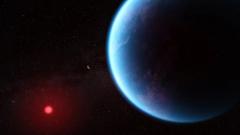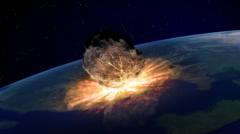Scientists from Cambridge University have unveiled intriguing yet preliminary signs of potential life on exoplanet K2-18b, located an astonishing 700 trillion miles away from Earth. Utilizing NASA’s James Webb Space Telescope (JWST), the team detected chemical signatures of molecules thought to be produced by simple life forms on Earth, specifically dimethyl sulphide (DMS) and dimethyl disulphide (DMDS). This marks the second instance of detecting life-associated chemicals in K2-18b's atmosphere, intensifying the ongoing exploration of extraterrestrial possibilities.
The lead researcher, Professor Nikku Madhusudhan, expressed optimism about confirming these potential life indicators soon. "This is the strongest evidence we have for life beyond Earth," he remarked from his lab at Cambridge’s Institute of Astronomy. The research team aims to achieve a higher standard of certainty—known as a five-sigma result—about the findings within one to two years for more robust validation.
K2-18b, approximately 2.5 times the size of Earth, is an intriguing candidate in the search for life. The JWST's advanced technology enables analysis of the planet’s atmospheric composition by capturing light filtered through the atmosphere, unveiling possible biological signatures. Prof. Madhusudhan noted that the detected gas amounts are significantly greater than what is observed on Earth, hinting at a potentially vibrant ecosystem if the association with life is valid.
However, the journey from detection to confirmation is fraught with challenges. Despite the promising data, the current findings do not yet reach the rigorous standard needed for discovery claims in the scientific community, with three-sigma results falling short of the necessary five-sigma benchmark. Independent experts like Professor Catherine Heymans emphasize that even increased certainty would not definitively prove extraterrestrial life, as non-biological processes could also generate these gases.
The Cambridge team is exploring alternative hypotheses, including laboratory conditions under which DMS and DMDS might arise without life. The lack of ammonia in the planet’s atmosphere suggests a significant water presence, but other theories propose the existence of molten rock oceans, which would be hostile to life. Divergent views exist on K2-18b’s planetary structure, with some researchers considering it a mini gas giant lacking a solid surface.
While researchers acknowledge the difficulties ahead in substantiating claims of life, they remain hopeful. Prof. Madhusudhan believes that this line of inquiry could redefine humanity’s understanding of its place in the universe. "In decades to come, we could look back at this moment as a pivotal point in our quest to answer whether we are alone in the cosmos."
The research on K2-18b has been published in The Astrophysical Journal Letters, promising continued dialogue and investigation in the scientific community surrounding this tantalizing prospect of life beyond Earth.
The lead researcher, Professor Nikku Madhusudhan, expressed optimism about confirming these potential life indicators soon. "This is the strongest evidence we have for life beyond Earth," he remarked from his lab at Cambridge’s Institute of Astronomy. The research team aims to achieve a higher standard of certainty—known as a five-sigma result—about the findings within one to two years for more robust validation.
K2-18b, approximately 2.5 times the size of Earth, is an intriguing candidate in the search for life. The JWST's advanced technology enables analysis of the planet’s atmospheric composition by capturing light filtered through the atmosphere, unveiling possible biological signatures. Prof. Madhusudhan noted that the detected gas amounts are significantly greater than what is observed on Earth, hinting at a potentially vibrant ecosystem if the association with life is valid.
However, the journey from detection to confirmation is fraught with challenges. Despite the promising data, the current findings do not yet reach the rigorous standard needed for discovery claims in the scientific community, with three-sigma results falling short of the necessary five-sigma benchmark. Independent experts like Professor Catherine Heymans emphasize that even increased certainty would not definitively prove extraterrestrial life, as non-biological processes could also generate these gases.
The Cambridge team is exploring alternative hypotheses, including laboratory conditions under which DMS and DMDS might arise without life. The lack of ammonia in the planet’s atmosphere suggests a significant water presence, but other theories propose the existence of molten rock oceans, which would be hostile to life. Divergent views exist on K2-18b’s planetary structure, with some researchers considering it a mini gas giant lacking a solid surface.
While researchers acknowledge the difficulties ahead in substantiating claims of life, they remain hopeful. Prof. Madhusudhan believes that this line of inquiry could redefine humanity’s understanding of its place in the universe. "In decades to come, we could look back at this moment as a pivotal point in our quest to answer whether we are alone in the cosmos."
The research on K2-18b has been published in The Astrophysical Journal Letters, promising continued dialogue and investigation in the scientific community surrounding this tantalizing prospect of life beyond Earth.








